Newark-on-Trent
Newark-on-Trent or Newark (/ˈnjuːərk/)[1] is a market town and civil parish[2] in the Newark and Sherwood district of the county of Nottinghamshire, England. It stands on the River Trent, the A1 – on the route of the ancient Great North Road, and the East Coast Main Line railway. The origins of the town are possibly Roman, as it lies on an important Roman road, the Fosse Way. The town grew around Newark Castle, now ruined, and a large market place, now lined with historic buildings. It was a centre for the wool and cloth trades. In the English Civil War, it was besieged by Parliamentary forces and relieved by Royalist forces under Prince Rupert. Today Newark has become a commuter town for the cities of Lincoln and Nottingham.
| Newark-on-Trent | |
|---|---|
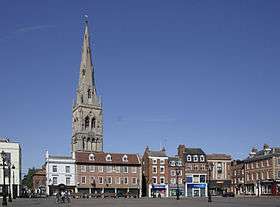 Market Square, Newark-on-Trent town centre | |
.svg.png) Arms of Newark | |
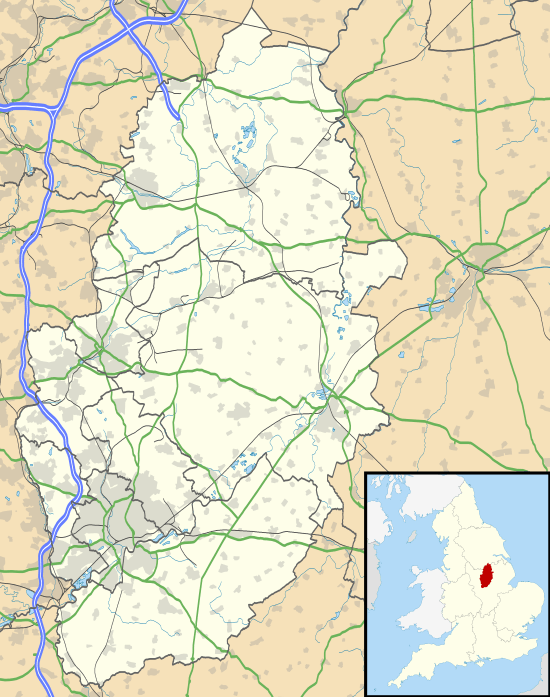 Newark-on-Trent Location within Nottinghamshire | |
| Population | 27,700 (2011) |
| Civil parish |
|
| District | |
| Shire county | |
| Region | |
| Country | England |
| Sovereign state | United Kingdom |
| Post town | NEWARK |
| Postcode district | NG22–NG24 |
| Dialling code | 01636 |
| Police | Nottinghamshire |
| Fire | Nottinghamshire |
| Ambulance | East Midlands |
| UK Parliament | |
History
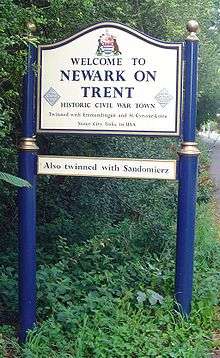
Early history
The place-name Newark is first attested in the Cartulary of Eynsham Abbey in Oxfordshire, where it appears as Newercha in about 1054–1057 and Niweweorche in about 1075–1092. It appears as Newerche in the 1086 Domesday Book. The name means 'New work', with the apparent meaning of "New fort".[3]
The origins of the town are possibly Roman, due to its position on an important Roman road, the Fosse Way. In a document which purports to be a charter of AD 664, Newark is mentioned as having been granted to the Abbey of Peterborough by King Wulfhere of Mercia. An Anglo-Saxon pagan cemetery, used from the early 5th to early 7th centuries, has been found in Millgate, Newark, close to the Fosse Way and the River Trent. There cremated remains were buried in pottery urns.[4]
In the reign of Edward the Confessor, Newark belonged to Godiva and her husband Leofric, Earl of Mercia, who granted it to Stow Minster in 1055. After the Norman Conquest, Stow Minster retained the revenues of Newark, but it came under the control of the Norman Bishop Remigius de Fécamp, after whose death control passed to the Bishops of Lincoln from 1092 until the reign of Edward VI. There were burgesses in Newark at the time of the Domesday survey. The reign of Edward III shows evidence that it had long been a borough by prescription. The Newark wapentake (hundred) in the east of Nottinghamshire was established in the period of Anglo-Saxon rule (10th–11th centuries).
Medieval to Stuart period
Newark Castle was originally a Saxon fortified manor house founded by King Edward the Elder. In 1073, Robert Bloet, Bishop of Lincoln, founded an earthwork motte-and-bailey fortress on the site. The river bridge was built about this time under a charter from Henry I, as was St Leonard's Hospital. The bishop also gained from the king a charter to hold a five-day fair at the castle each year, and under King Stephen to establish a mint. King John died of dysentery in Newark Castle in 1216.[5]
The town became a local centre for the wool and cloth trade – by the time of Henry II a major market was established. Wednesday and Saturday markets in the town were founded in the period 1156–1329, under a series of charters from the Bishop of Lincoln.[6] After his death, Henry III tried to bring order to the country, but the mercenary Robert de Gaugy refused to yield Newark Castle to the Bishop of Lincoln, its rightful owner. This led to the Dauphin of France (later King Louis VIII of France) laying an eight-day siege on behalf of the king, ended by an agreement to pay the mercenary to leave. Around the time of Edward III's death in "1377 Poll tax records show an adult population of 1,178, excluding beggars and clergy, making Newark one of the biggest 25 or so towns in England".[7]
In 1457 a flood swept away the bridge over the Trent. Although there was no legal requirement to do so, the Bishop of Lincoln, John Chaworth, funded a new bridge of oak with stone defensive towers at either end. In January 1571 or 1572, the composer Robert Parsons fell into the swollen River Trent at Newark and drowned.[8]
After the break with Rome in the 16th century, the establishment of the Church of England, and the Dissolution of the Monasteries, Henry VIII had the Vicar of Newark, Henry Lytherland, executed for refusing to acknowledge the king as head of the Church. The dissolution affected Newark's political landscape, and even more radical changes came in 1547, when the Bishop of Lincoln exchanged ownership of the town with the Crown. Newark was incorporated under an alderman and twelve assistants in 1549, and the charter was confirmed and extended by Elizabeth I.
Charles I reincorporated the town under a mayor and aldermen, owing to its increasing commercial prosperity. This charter, except for a temporary surrender under James II, continued to govern the corporation until the Municipal Corporations Act 1835.
The Civil War
During the English Civil War, Newark was a mainstay of the Royalist cause, Charles I having raised his standard in nearby Nottingham. "Newark was besieged on three occasions and finally surrendered only when ordered to do so by the King after his own surrender."[9] It was attacked in February 1643 by two troops of horsemen, but beat them back. The town fielded at times as many as 600 soldiers, and raided Nottingham, Grantham, Northampton, Gainsborough and other places with mixed success, but enough to cause it to rise to national notice. At the end of 1644 it was besieged by forces from Nottingham, Lincoln and Derby, until relieved in March by Prince Rupert.
Parliament commenced a new siege towards the end of January 1645 after more raiding, but this was relieved about a month later by Sir Marmaduke Langdale. Newark cavalry fought with the king's forces, which were decisively defeated in the Battle of Naseby, near Leicester in June 1645.
The final siege began in November 1645, by which time the town's defences had been greatly strengthened. Two major forts had been constructed just outside the town, one called the Queen's Sconce to the south-west, and another, the King's Sconce, to the north-east, both close to the river, with defensive walls and a water-filled ditch of 2¼ miles around the town. The King's May 1646 order to surrender was only accepted under protest by the town's garrison. After that, much of the defences was destroyed, including the Castle, which was left in essentially the state it can be seen today. The Queen's Sconce was left largely untouched and its remains are in Sconce and Devon Park.
Georgian era and early 19th century
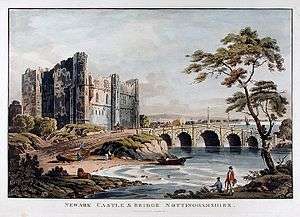
Around 1770 the Great North Road around Newark (now the A1) was raised on a long series of arches to ensure it remained clear of the regular floods. A special Act of Parliament in 1773 allowed the creation of a town hall next to the Market Place. Designed by John Carr of York and completed in 1776, Newark Town Hall is now a Grade I listed building, housing a museum and art gallery. In 1775 the Duke of Newcastle, at the time the Lord of the Manor and a major landowner in the area, built a new brick bridge with stone facing to replace a dilapidated one next to the Castle. This is still one of the town's major thoroughfares today.
A noted 18th-century advocate of reform in Newark was the local printer and newspaper owner Daniel Holt (1766–1799). He was imprisoned for printing a leaflet advocating parliamentary reform, and for selling a pamphlet by Thomas Paine.[10]
In a milieu of parliamentary reform, the Duke of Newcastle evicted over a hundred tenants at Newark whom he believed to support directly or indirectly at the 1829 elections the Liberal/Radical candidate (Wilde), rather than his candidate, (Michael Sadler, a progressive Conservative).[11]
J. S. Baxter, a schoolboy in Newark in 1830–1840, contributed to The Hungry Forties: Life under the Bread Tax (London, 1904), a book about the Corn Laws: "Chartists and rioters came from Nottingham into Newark, parading the streets with penny loaves dripped in blood carried on pikes, crying 'Bread or blood'."
19th–21st centuries
Many new buildings and much industry appeared in the Victorian era. The new buildings included the Independent Chapel (1822), Holy Trinity (1836–1837), Christ Church (1837), Castle Railway Station (1846), the Wesleyan Chapel (1846), the Corn Exchange (1848), the Methodist New Connexion Chapel (1848), W. N. Nicholson Trent Ironworks (1840s), Northgate Railway Station (1851), North End Wesleyan Chapel (1868), St Leonard's Anglican Church (1873), the Baptist Chapel (1876), the Primitive Methodist Chapel (1878), Newark Hospital (1881), Ossington Coffee Palace (1882), Gilstrap Free Library (1883), the Market Hall (1884), the Unitarian Chapel (1884), the Fire Station (1889), the Waterworks (1898), and the School of Science and Art (1900).
The Ossington Coffee Palace was built by Lady Charlotte Ossington, daughter of the 4th Duke of Portland and widow of the former Speaker of the House of Commons, Viscount Ossington, designed to be a Temperance alternative to pubs and coaching inns.[12]
These changes and associated industrial expansion raised the population from under 7,000 in 1800 to over 15,000 by the end of the 19th century. The Sherwood Avenue Drill Hall opened in 1914, just as the First World War began.[13]
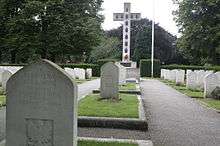
During the Second World War, there were several RAF stations within a few miles of Newark, from many of which operated squadrons of the Polish Air Force. A special plot was set aside in Newark Cemetery for RAF burials and this is now the war graves plot, where all but ten of the 90 Commonwealth and all of the 397 Polish burials were made. The cemetery also contains 49 scattered burials from the First World War. A memorial cross to the Polish airmen buried here was unveiled in 1941 by President Raczkiewicz, ex-President of the Polish Republic and head of the wartime Polish Government in London, supported by General Sikorski, head of the Polish Armed Forces and wartime Polish Prime Minister. When both men died – General Sikorski in 1943 and President Raczkiewicz in 1947 – they were buried at the foot of the memorial. General Sikorski's remains were returned to Poland in 1993, but there is still a memorial to him in Newark.[14]
The prime industries in Newark in the last hundred years have been the manufacture of clothing, bearings, pumps, agricultural machinery and pine furniture, and the refining of sugar. British Sugar still has one of its sugar-beet processing factories to the north of the town near the A616 (Great North Road). There have been several factory closures, especially since the 1950s. The breweries in the town that closed in the 20th century included James Hole[15][16] and Warwicks-and-Richardsons.[17][18]
Population
The estimated population for Newark parish in 2007 was 26,330, increasing to 27,700 at the 2011 census.[19] According to the 2001 census, it had a population of 25,376. The ONS Mid Year Population Estimates for 2007 indicate that the population had increased to some 26,700.[20] "The population of Newark is approximately 35,000 and the rural area of Newark and Sherwood to the west of the town has an additional population of 75,000 in the small towns of Southwell and Ollerton and the numerous villages of the district."[21]
In ethnographic terms, Newark is 93 per cent white British, according to the 2011 census. It is also prosperous: 77 per cent of adults are employed, according to the latest ONS data, compared with a national average of 72 per cent. Earnings are 7 per cent above the average in the surrounding East Midlands.
Geography
Newark lies on the River Trent, with the River Devon also running through the town. Standing at the intersection of the Great North Road and the Fosse Way, Newark originally grew around Newark Castle, now ruined, and a large market place now lined with historic buildings.
Newark forms a continuous built-up area with the neighbouring parish of Balderton to the south-east. To the south, along the A46 road, is Farndon, and to the north Winthorpe.
Newark's growth and development have both been enhanced by having one of few bridges over the River Trent, by the navigability of the river, by the presence of the Great North Road (the A1, etc.), and later by the advance of the railways, bringing a junction between the East Coast Main Line and the Nottingham to Lincoln route. "Newark became a substantial inland port, particularly for the wool trade,"[22] though it industrialised to some extent in the Victorian era, and later with an ironworks, engineering, brewing, and a sugar refinery.
The A1 bypass was opened in 1964 by the then Minister of Transport, Ernest Marples.[23] The single-carriageway, £34-million A46 opened in October 1990.
Governance
Newark returned two representatives to the Unreformed House of Commons from 1673. It was the last borough to be created before the Reform Act. William Ewart Gladstone, later Prime Minister, became its MP in 1832 and was re-elected in 1835, 1837 and 1841 (twice), but possibly due to his support of the repeal of the Corn Laws and other issues he stood elsewhere after that time.
Newark elections were central to two interesting legal cases. In 1945, a challenge to Harold Laski, the Chairman of the National Executive Committee of the Labour Party, led Laski to sue the Daily Express when it reported him as saying that Labour might take power through violence if defeated at the polls. Laski vehemently denied saying this, but lost the libel action. In the 1997 general election, Newark returned Fiona Jones of the Labour Party. Jones and her election agent Des Whicher were convicted of submitting a fraudulent declaration of expenses, but the conviction was overturned on appeal.
Newark's former MP[24] is Patrick Mercer, Conservative. Mercer held the position of Shadow Minister for Homeland Security from June 2003 until March 2007, when he was forced to resign after making racially contentious comments made to The Times.[25]
After a by-election on 5 June 2014 brought about by the resignation of Patrick Mercer, he was replaced by the Conservative Robert Jenrick, who was re-elected at the general election of 7 May 2015.[26]
Newark has three local-government tiers: Newark Town Council, Newark and Sherwood District Council and Nottinghamshire County Council. The 39 district councillors cover waste, planning, environmental health, licensing, car parks, housing, leisure and culture. The District Council opened a national Civil War Centre and Newark Museum in May 2015. Ten county councillors are elected to Nottinghamshire County Council for the area.[27] Nottinghamshire County Council provides children's services, adult care, and highways and transport services. The town has an elected council of 18 members from four wards.[28] Newark Town Council has taken on some responsibilities devolved by Newark and Sherwood District Council, including parks, open spaces and Newark Market. It also runs events such as the LocAle and Weinfest,[29] a museum in the Town Hall,[30] and allotments.[31]
A new police station, costing £7 million, opened in October 2006.[32]
Education
The Newark Academy is a mixed secondary school situated in nearby Balderton.[33]
Economy
British Sugar PLC runs a mill on the outskirts of the town that opened in 1921. It has 130 permanent staff and processes 1.6 million tonnes of sugar beet produced by about 800 UK growers, at an average distance of 28 miles from the factory. Of the output, 250,000 tonnes are processed and supplied to food and drink manufacturers in the UK and across Europe. At the heart of the Newark factory's operations is a combined heat and power (CHP) plant, with boilers fuelled by natural gas to meet the site's steam and electricity requirements and contribute to the grid enough power for 800 homes. The installation is rated under the government CHP environmental quality-assurance scheme.
Another employer is a bearings factory (part of the NSK group) with some 200 employees. A further notable employer is Laurens Pattisseries[34], part of the food group Bakkavör since May 2006, which bought it for £130 million. It employs over 1,000 people. In 2007, Currys opened a £30 million national distribution centre next to the A17 near the A46 roundabout, and Dixon's moved its national distribution centre there in 2005, with over 1,400 staff employed at the site at peak times. Flowserve, formerly Ingersoll Dresser Pumps, has a manufacturing facility in the town. Project Telecom in Brunel Drive was bought by Vodafone in 2003 for a reported £163 million. Since 1985 Newark has been host to the biggest antiques outlet in Europe, the Newark International Antiques and Collectors Fair, held bi-monthly at Newark Showground. Newark has plentiful antique shops and centres.
Culture
Newark hosts Newark Rugby Union Football Club, whose players have included Dusty Hare, John Wells, Greig Tonks and Tom Ryder.[35] The town has a leisure centre in Bowbridge Road, opened in 2016.
Newark and Sherwood Concert Band has over 50 regular players and has performed at numerous area events in the last few years. Also based in Newark are the Royal Air Force Music Charitable Trust and Lincolnshire Chamber Orchestra.[36]
The Palace Theatre in Appletongate is Newark's main entertainment venue, offering drama, live music, dance and film.
The National Civil War Centre and Newark Museum, next to the Palace Theatre in Appletongate in the town centre, opened in 2015 to interpret Newark's part in the English Civil War in the 17th century and explore its wider implications.[37]
Landmarks and treasures
- The Market Place is the town's focal point. It includes The Queen's Head, one of the town's old pubs.
- The Church of St. Mary Magdalene is a Grade I listed building, notable for its tower and octagonal spire (236 feet (72 m) high), the tallest in the county. It was heavily restored in the mid-19th century by Sir George Gilbert Scott. The reredos was added by Sir Ninian Comper.[38]
- Newark Castle was built by the Trent by Alexander of Lincoln, the Bishop of Lincoln in 1123, who established it as a mint.[39] Of the original Norman stronghold, the chief remains are the gate-house, a crypt and the tower at the south-west angle. King John died at the castle on the night of 18 October 1216.[40][41] In the reign of Edward III it was used as a state prison. During the English Civil War it was garrisoned for Charles I and endured three sieges. Its dismantling was begun in 1646, after the surrender of the king.
- The 16th-century Governor's House, named after Sir Richard Willis, Castle Governor in the English Civil War, is in Stodman Street. Now housing a bread shop and cafe, it is a Grade I listed building.[42]
Newark Torc
The Newark Torc, a silver and gold Iron Age torc, was the first found in Nottinghamshire. It closely resembles that of the Snettisham Hoard. Uncovered in 2005, it occupies a field on the town's outskirts,[43] and in 2008 was acquired by Newark and Sherwood District Council.[44] The torc was displayed at the British Museum in London until the opening of the National Civil War Centre and Newark Museum in May 2015. It is now shown in the museum galleries.
Churches and other religious sites
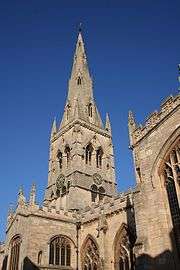
Newark's churches include the Grade I listed parish church, St Mary Magdalene. Other Anglican churches include Christ Church in Boundary Road and St Leonard's in Lincoln Road. The Catholic Holy Trinity Church was consecrated in 1979.[45] Other places of worship include three Methodist churches,[46] the Baptist Church in Albert St, and the Church of Promise, founded in 2007.[47]
In 2014 the Newark Odinist Temple, a Grade II listed building in Bede House Lane, was consecrated according to the rites of the Odinist Fellowship, making this the first heathen temple operating in England in modern times.[48][49]
Transport
Newark has two railway stations. The East Coast Main Line serves Newark North Gate railway station with links to London, King's Cross, Leeds, Hull, Newcastle upon Tyne and Edinburgh. Newark Castle railway station on the Leicester–Nottingham–Lincoln line provides cross-country regional links. The two cross at the last flat crossing in Britain.[50] Grade separation has been proposed.[51]
The main roads of Newark include the A1 and A46 as bypasses. The A17 runs east to King's Lynn in Norfolk, and the A616 north to Huddersfield in West Yorkshire. The bus-service providers include Stagecoach in Lincolnshire ("Newark busabouttown"),[52] Marshalls and Travel Wright,[53] under the control of Nottinghamshire County Council,[54]
Media
The town's weekly Newark Advertiser, founded in 1854, is owned by Newark Advertiser Co Ltd, which also publishes local newspapers in Southwell and Bingham.[55]
The community station Radio Newark began broadcasting on 107.8 FM in May 2015, after three successful trials in 2014 and 2015. The station replaces a former community station, Boundary Sound, which ceased broadcasting in 2011.
Notable people
Armed forces
- Gonville Bromhead (1845–1891), army officer and Victoria Cross recipient educated at Magnus Grammar School
- John Cartwright (1740–1824), naval officer, militia major and political reformer educated in Newark
Fine arts
- William Caparne (1855–1940) – botanical artist and horticulturalist born in Newark
- William Cubley (1816–1896) – artist settled in Newark
- William Nicholson (1872–1949) – painter and illustrator born in Newark
Literature
- George Allen (1832–1907) – engraver and publisher born in Newark
- John Barnard (died 1683) – biographer and religious writer, who died in Newark
- Cornelius Brown (1852–1907) – journalist and historian, Newark Advertiser[56]
- Henry Constable (1562–1613) – a poet (early sonneteer) born in Newark
- Winifred Gales (1761–1839) – a novelist and memoirist[57]
- T. W. Robertson (1829–1871) – a playwright[58]
Music
- John Blow (1649–1708) – composer and organist[59]
- Ian Burden (born 1957) – keyboard player with the Human League
- Jay McGuiness (born 1990) – band singer with The Wanted[60]
Politics and government
- Richard Alexander (1934–2008) – Conservative politician[61]
- Ted Bishop (1920–1984) – Labour politician, created Baron Bishopston of Newark in the County of Nottinghamshire
- William Robert Bousfield (1854–1943) – Conservative politician, lawyer and psychologist born in Newark
- Sir Bryce Chudleigh Burt (1881–1943) – administrator in the British Raj born in Newark
- John Cartwright (1740–1824) – politician and preacher, attended Newark Grammar School.
- Robert Constable (1522–1591) – parliamentarian and soldier
- Robert Heron (1765–1854) – Whig politician[62]
- Robert Jenrick (born 1982) – Conservative politician, MP for Newark since June 2014
- King John of England (1166–1216) – died in Newark.
- Fiona Jones (1957–2007) – Labour politician, MP for Newark[63]
- Patrick Mercer (born 1956) – Conservative politician, MP for Newark 2001–2014
- Arthur Richardson (1860–1936) – Liberal/Labour politician who attended Magnus Grammar School
Religion
- Alexander of Lincoln (died 1148) – Bishop of Lincoln, founded a hospital for lepers in Newark.
- Annette Cooper (born 1953) – Anglican Archdeacon of Colchester, educated at Lilley and Stone Girls' High School in Newark
- John Burdett Wittenoom (1788–1855) – pioneer cleric and headmaster in Swan River Colony, Australia, born in Newark
Science and technology
- John Arderne (1307–1392) – notable surgeon, lived in Newark in early life.
- Basil Baily (1869–1942) – architect
- Francis Clater (1756–1823) – farrier and veterinary writer
- Godfrey Hounsfield (1919–2004) – electrical engineer, Nobel Laureate in medicine, inventor of the CT scanner[64]
- Rupert Sheldrake (born 1942) – biochemist and parapsychology researcher born in Newark
- Giovanni Francisco Vigani (c. 1650–1712) – chemist from Verona, who first settled in Newark in 1682
- Frederick Smeeton Williams (1829–1886) – writer on railways[65]
Sports
- Willie Hall (1912–1967) – Notts County, Tottenham Hotspur and England footballer who scored the fastest international hat trick ever (4 minutes against Northern Ireland, 16 November 1938)
- Steve Baines (born 1954) – League footballer and referee[66]
- Phil Crampton (born 1970) - professional alpinist and high-altitude mountaineer
- Craig Dudley (born 1979) – professional association footballer
- Harry Hall (born 1893 – death date unknown) – professional association footballer
- Dusty Hare (born 1952) – rugby union international
- Phil Joslin (born 1959) – league football referee[67]
- Mary King (born Thomson, 1961) – Olympic equestrian sportswoman
- Sam McMahon (born 1976) – professional association footballer[68]
- Shane Nicholson (born 1970) – league footballer[69]
- Henry Slater (1839–1905) – first-class cricketer born in Newark
- Mark Smalley (born 1965) – professional association footballer born in Newark
- William Streets (born 1772, fl. 1792–1803) – cricketer[70]
Stage and screen
- Thomas William Robertson (1829–1871), born in Newark, usually known professionally as T. W. Robertson – dramatist and innovative stage director best known for a series of plays produced in London
- Arthur Leslie (1899–1970) – actor and playwright, born in Newark
- Norman Pace (born 1953) – actor and comedian
- Terence Longdon (1922–2011) – screen actor[71]
- Donald Wolfit (1902–1968) – Shakespearean actor[72][73]
- Toby Kebbell (born 1982) – actor educated at the Grove School[74]
Twin towns
Since 1984 Newark has been twinned with:



References
- Collins Dictionary "Newark-on-Trent in British". collinsdictionary.com. Retrieved 12 July 2018.
- "Newark". Mapit. Archived from the original on 5 May 2018. Retrieved 10 February 2018.
- Eilert Ekwall, The Concise Oxford Dictionary of English Place-names, p. 339.
- Kinsley, A. G. (1989). The Anglo-Saxon Cemetery at Millgate, Newark-on-Trent, Nottinghamshire. Excavations between 1958 and 1978. Nottingham Archaeological Monographs. ISBN 0-904857-02-6.
- Watson, Greig (19 October 2016). "King John: Dysentery and the death that changed history". BBC. Archived from the original on 11 November 2017. Retrieved 11 November 2017.
- (web), Samantha Letters (content); Olwen Myhill (18 June 2003). "Gazetteer of Markets and Fairs to 1516: Nottinghamshire". www.history.ac.uk. Archived from the original on 27 October 2017. Retrieved 5 May 2018.
- Newark Future, 2008 Archived 22 July 2011 at the Wayback Machine.
- Humphreys, Maggie; Evans, Robert (1997). Dictionary of composers for the Church in Great Britain and Ireland (1. publ. ed.). London: Mansell. ISBN 9780720123302.
- Newark Civil War Trail Archived 13 June 2011 at the Wayback Machine.
- An account of Holt's life by Alan Dorling appears in the Nottinghamshire Historian journal, spring/summer 2000, pp. 9–15, with further detail in autumn/winter 2003, pp. 8–12.
- See the report in Cornelius Brown 1907, ii, 243 following; and the report in the Times for 7 October 1829. A report in the Times of 10 September 1832 lists ten of the evicted people by name and address.
- "Ossington Coffee Palace". Welcome to Newark-on-Trent.
- "Newark on Trent". The Drill Halls Project. Archived from the original on 10 September 2017. Retrieved 9 September 2017.
- "Newark upon Trent Cemetery". Commonwealth War Graves Commission. Archived from the original on 15 October 2012. Retrieved 23 June 2012.
- "Hole & Co. Ltd – Brewery History Society Wiki".
- "James Hole and Co – Graces Guide". www.gracesguide.co.uk.
- "Warwicks & Richardsons Ltd - Brewery History Society Wiki".
- "Warwick and Richardson – Graces Guide". www.gracesguide.co.uk.
- "Town population 2011". Neighbourhood Statistics. Office for National Statistics. Archived from the original on 24 September 2016. Retrieved 12 April 2016.
- "Nottinghamshire - the County". nottinghamshire.gov.uk. Nottinghamshire County Council. Archived from the original on 1 December 2008. Retrieved 21 August 2009.
- The Town of Newark-on-Trent Archived 1 July 2009 at the Wayback Machine, Lincoln College.
- Andrew Nicholson, Newark-on-Trent Archived 30 October 2009 at the Wayback Machine at Nottinghamshire Heritage Gateway.
- "The A1 By-Pass". Winthorpe Village, Nottinghamshire. Archived from the original on 28 October 2017. Retrieved 5 May 2018.
- "Helmer to fight Newark seat for UKIP". BBC News. 6 May 2014. Archived from the original on 10 December 2014. Retrieved 5 May 2018 – via www.bbc.co.uk.
- Byers, David (8 March 2007). "Tory front-bencher sparks race row with 'black bastards' gibe". The Times. London. Archived from the original on 20 March 2007.
- "Conservatives win Newark by-election". BBC News. 6 June 2014. Archived from the original on 12 October 2016. Retrieved 5 May 2018 – via www.bbc.co.uk.
- "County Councillors by district – Nottinghamshire County Council". nottinghamshire.gov.uk. 2011. Archived from the original on 12 January 2012. Retrieved 29 August 2011.
- "Meet your Councillors – Newark Town Council". newark.gov.uk. 2011. Archived from the original on 31 March 2012. Retrieved 29 August 2011.
- "LocAle & Weinfest – Newark Town Council". newark.gov.uk. 2011. Archived from the original on 31 March 2012. Retrieved 29 August 2011.
- "Museum – Newark Town Council". newark.gov.uk. 2011. Archived from the original on 7 September 2011. Retrieved 29 August 2011.
- "Allotments – Newark Town Council". newark.gov.uk. 2011. Archived from the original on 7 August 2011. Retrieved 29 August 2011.
- Jarram, Matt (5 July 2019). "Officers could leave or share police station just 13 years after it was built". nottinghampost.
- "The Newark Academy". The Newark Academy. Retrieved 10 February 2014.
- Laurens Patisseries
- "John Wells honoured by Newark". rfu.com. 2011. Archived from the original on 12 January 2012. Retrieved 29 August 2011.
- "Malcolm Goodman MBE ARCM Lincolnshire Chamber Orchestra". www.malcolmgoodman.com. Archived from the original on 16 April 2018. Retrieved 5 May 2018.
- "National Civil War Centre, Newark". www.nationalcivilwarcentre.com. Archived from the original on 7 January 2018. Retrieved 5 May 2018.
- Historic England, "Church of St Mary Magdalene and attached railing (1279450)", National Heritage List for England, retrieved 22 August 2017
- Pettifer, pp. 148 and 201.
- Fryde, Greenway, Porter and Roy, p. 37.
- Warren, pp. 254–255.
- "Governor's House, Newark". British Listed Buildings. Archived from the original on 22 February 2014. Retrieved 10 February 2014.
- Wainwright, Martin (20 November 2008). "Iron age necklace discovered". The Guardian. London. Archived from the original on 17 September 2014. Retrieved 20 November 2008.
- "Necklace goes on show after 2,000 years in farmer's field". The Scotsman. Edinburgh. 18 February 2005. Retrieved 20 November 2008.
- "Holy Trinity Parish RC Community, Newark – Roman Catholic Church". holytrinitynewark.org.uk. 2011. Archived from the original on 14 January 2012. Retrieved 29 August 2011.
- Newark Methodist Circuit. Retrieved 23 April 2020.
- "Church of Promise in Newark". churchofpromise.org.uk. 2011. Archived from the original on 31 March 2012. Retrieved 29 August 2011.
- "Newark Odinist Temple". 2014.
- "Temple in Town – A Spiritual Alternative". Newark Advertiser. 18 June 2015.
- Benedict le Vay (2009). Britain from the Rails: A Window Gazer's Guide. Bradt Travel Guides. p. 6. ISBN 9781841622774. Archived from the original on 11 November 2013. Retrieved 29 August 2011.
- "East Midlands Route Utilisation Strategy" (PDF). Archived from the original (PDF) on 7 June 2011. Retrieved 8 June 2010.
- "Newark Town Guide] stagecoachbus.com" (PDF). stagecoachbus.com. Archived from the original (PDF) on 13 January 2012. Retrieved 5 May 2018.
- "Bus operators – Nottinghamshire County Council". nottinghamshire.gov.uk. 2011. Archived from the original on 13 December 2011. Retrieved 29 August 2011.
- "Local bus service strategy – Nottinghamshire County Council". nottinghamshire.gov.uk. 2011. Archived from the original on 13 December 2011. Retrieved 30 August 2011.
- "Newark Advertiser | British Newspapers Online". britishpapers.co.uk. 2011. Archived from the original on 3 October 2011. Retrieved 29 August 2011.
- "Nottinghamshire history > A History of Nottinghamshire, (1896)". www.nottshistory.org.uk. Archived from the original on 3 March 2016. Retrieved 5 May 2018.
- R. B. Elliot (1986) and Winifred Marshall Gales, Dictionary of North Carolina Biography (Vol. 2, pp. 270). Chapel Hill: University of North Carolina Press.
- ODNB entry: Retrieved 9 September 2011. Subscription required.
- ODNB entry: Retrieved 9 September 2011. Subscription required.
- This Is Nottingham site: Retrieved 19 June 2011. Archived 19 September 2012 at Archive.today
- Obituary: Retrieved 9 September 2011. Archived 4 July 2017 at the Wayback Machine
- ODNB entry: Retrieved 9 September 2011. Subscription required.
- "Fiona Jones; Obituary". Telegraph.co.uk (Telegraph Media Group). 8 February 2007. Retrieved 2008-11-01.
- ODNB entry: Retrieved 9 September 2011. Subscription required.
- ODNB entry: Retrieved 9 September 2011. Subscription required.
- Playing profile : Chesterfield FC Official website.
- Retrieved 9 September 2011. Archived 26 September 2012 at the Wayback Machine See his page for further references.
- Soccerbase Retrieved 27 January 2016. Archived 1 February 2016 at the Wayback Machine
- Soccer Base Retrieved 9 September 2011. Archived 4 November 2012 at the Wayback Machine
- Cricket Archive site: Retrieved 9 September 2011. Archived 27 October 2017 at the Wayback Machine
- Obituary: Retrieved 9 September 2011. Archived 30 March 2016 at the Wayback Machine
- Magnus School, History & Alumni Archived 9 July 2012 at the Wayback Machine
- "Donald Wolfit". www.nndb.com. Archived from the original on 2 July 2016. Retrieved 5 May 2018.
- "Toby Kebbell Drops Out and Tunes In" Retrieved 3 December 2017 Archived 5 December 2017 at the Wayback Machine
- "Home". newarktwinning.co.uk. 2009. Archived from the original on 23 May 2013. Retrieved 29 August 2011.
- Bibliography

- Smyth, Victor (1993). Life of a country boy 1925–1940: one boy's life in the Newark area.
- Mallory, Robert (1995). Newark in the Second World War. West Bridgford: Nottinghamshire County Council and Newark and Sherwood District Council.
External links
| Wikivoyage has a travel guide for Newark-on-Trent. |
| Wikisource has the text of a 1911 Encyclopædia Britannica article about Newark-on-Trent. |
- Newark Town Council
- Thoroton Society bibliography
- Newark Carnival Community carnival for Newark
- . New International Encyclopedia. 1905.